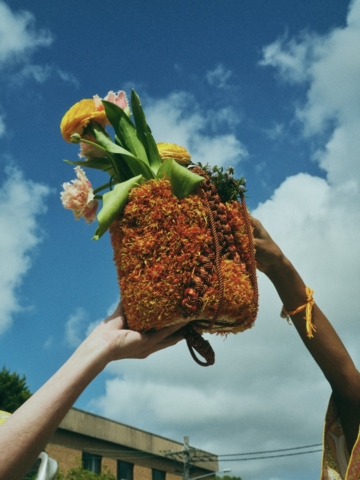Frog – Pond – Plop
By Chris McCabe
Frog – Pond – Plop: Chris McCabe explores the modern world of the ancient three-line, a syllable-specific Japanese form of poetry. He explores this form of poetry that consists of three lines, the first line made up of five syllables, seven in the second line, and five in the final line. Haiku traditionally don’t rhyme, as they are so short, and they are typically written on the topic of nature and the natural world. Yet here he highlights some Radical Haikus in this form from the National Poetry Library collection, Image National Poetry Library. Image Pete Woodhead
No haiku without a frog, you might think. Yet despite the classical Japanese roots of the form, with its focus on moments in nature – and the rigidity of the famous 5-7-5 syllabic form – the haiku has been radically reinvented by modern and contemporary poets.
The Japanese poet Bashō (1644-1694) defined what we think of as haiku poetry:
precise, imagistic and naturalistic. Take his famous frog poem:
ancient is the pond —
suddenly a frog leaps — now!
the water echoes
(translated by Tim Chilcott)
As this example suggests, the precision of the form and theme of nature are not separate from each other. You could think of a haiku as the shutting of the lens of a camera; the interaction of light, lens and physical presence make the artwork possible. In Bashō’s poem, the ‘now’ of the action is forever contained in the poem, which connects the experience with readers. The ‘echoes’ of the frog ripple out, through poetic form, into the future.
Over six thousand miles away from Japan, black poets from the 1960s onwards have found the haiku to be a perfect poetic form for a very different kind of poem: resistant, activist and political.
Sonia Sanchez (born in 1934) was a leading figure in the Black Arts Movement. Many of her haikus extend what the form can do by adding pauses (known as caesuras) to the middle of lines; a difficult technique to handle with so few syllables. This captures the rhythm of thinking and perhaps of speech, showing that this traditional form was quite capable of also containing many of the new
techniques that 20th Century poets were exploring:
if i had known, if
i had known you, i would have
left my love at home.
Sanchez re-angles the lens of haiku away from nature, toward the racism and tensions of black lives in America:
i see you blackboy
bent toward destruction watching
for death with tight eyes
Etheridge Knight (1931-1991) was also an African American poet who
similarly employed the haiku to reflect racial tensions in the States. One of his haikus of the 1960s captures the moment of Martin Luther King’s assassination, showing the form could be as equally valid as a method of political documentation as it had been for nature journaling:
Poor Martin L. King!
Death rains steel / down Beale Street
Poor Memphis Tennessee!
For Knight, wondering if the haiku was capable of being modern was the wrong question to ask; instead, a poet should be thinking about what they can inject into the form, to make it relevant to the times. As he said to one interviewer:
‘I don’t see haiku as a black form, but, then, you utilize whatever modes or vehicles are available to you.’
Where traditional Japanese haiku avoids emotive ideas and language, Black American poets did not have that privilege and adapted the form to their concerns. The radicalisation of the haiku has continued on this side of the Atlantic too.
John Cooper Clarke (born in 1949), famously from Salford (nearly six thousand miles from Tokyo) is definitely not known for his nature poems. His gift for extended and expressive lyrics perhaps – unsurprisingly – means that his attempt to write a haiku is thwarted by the ‘rules’ of the form. As a poet who writes about the poverty endemic to his native city, it is no surprise to find him
transform that restriction into a virtue:
To-con-vey one’s mood
In sev-en-teen syll-able-s
Is ve-ry dif-fic
In a sense, the traditional rules of haiku work like credit here: the numbers need to balance, and there is no overdraft. Other poets have radicalised the haiku by dispensing with the strict form
altogether. Subverting the seventeen-syllable stricture has become a standard deployment of contemporary poets. Why not? The same has been done for the sonnet over the centuries. Edwin Morgan (1920-2010) was a dynamic innovator, writing a ‘Summer Haiku’ that seems to take the sounds of Bashō’s
water-bound frog and translates them through a computer:
P o o l.
P e o p l
e p l o p!
C o o l.
Morgan was associated with the concrete poetry movement (1950s-1970s), which relished in the reduction of language to minimal, one word poems, sometimes deploying particles of language. The focus on the syllable was just as important for these poets as it was for Bashō.
One of the most interesting of these poets was Dom Sylvester Houédard (1924-1992), a monk by day and experimental poet by night, who was so influenced by the new minimalism he reduced his name to ‘dsh’.

Drawing on his love of concrete and minimal poetry, created on his ‘cosmic typewriter’, dsh wrote a radical translation of Bashō’s famous frog poem. What seems at once little more than a joke might actually be the ultimate haiku, taking the idea of capturing –
and immortalising – a moment in nature to the ultimate degree. In dsh’s poem, the vision of the frog is no longer something that happened to a poet; the onus is instead placed on the reader to imagine the scene, making it happen in their mind, for the first time:
Frog – pond – plop
Perhaps the flaw with traditional haikus is that they’re too long. Why take seventeen syllables when you can use just three?
Chris McCabe, National Poetry Librarian explores the modern world of the ancient three-line, syllable-specific Japanese form of poetry. The haiku consists of three lines, the first line made up of five syllables, seven in the second line, and five in the final line. Haiku poems traditionally do not rhyme, as they are so short, and they are typically written on the topic of nature and the natural world. Yet, here Chris highlights some Radical Haikus from the National Poetry Library collection that push the boundaries of the haiku form.
The National Poetry Library is situated on the fifth floor of the Southbank Centre’s Royal Festival Hall. It is the largest public collection of modern poetry in the world, with over 200,000 items, hosting events and exhibitions. The library is free to use. www.nationalpoetrylibrary.org.uk
If you enjoyed reading Frog – Pond – Plop then why not read Concrete Poetry here
.Cent Magazine, London. Be Inspired;Get Involved



